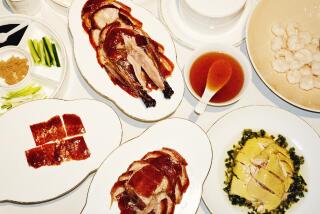Flower power, Beijing style: China goes big on blooms for National Day
With a heavy drizzle threatening to become a downpour and the sky turning ashen Wednesday afternoon, a thirtysomething landscaping boss and his work crew of a dozen leathery-faced women were hastily arranging a thousand flower pots of purple mums on a street corner in central Beijing.
“Hurry, hurry!” the boss urged the women — every one of them old enough to be his mother — as they pulled the containers out of blue plastic crates and set them into a swirly pattern on the pavement between 1,500 pots of spiky red blooms and hundreds of flats of green ground cover.
Earlier, a platform of greenery about 5 feet high and 20 feet in diameter had been erected, and red figures resembling dancing musicians placed on top.
It wasn’t just the weather that had the boss antsy. He had a hard deadline to meet: The huge display was part of the pomp for Thursday’s National Day celebrations.
Pasadena may have the Rose Parade, but Beijing is likewise gaga for large-scale floral design (albeit of the stationary variety). Each year, the flower power peaks on the Oct. 1 holiday when the country marks the founding of Communist China with a series of giant topiary-like arrangements around the city.
This year there are 200 of them, with the most elaborate situated along the Avenue of Eternal Peace leading to Tiananmen Square.
The massive displays are often a surprise to foreign tourists who come to the smog-plagued Chinese capital expecting little but gray.
“What’s the story with these?” asked Kevin O’Riordan, a 36-year-old Irishman paying his first visit to Beijing on Wednesday. “I kind of like them. They seem to reflect the culture.”
Part beautification and part indoctrination, the 3-D designs range from 45-foot-tall flower baskets with traditional peony motifs to displays highlighting the most au courant Communist Party propaganda slogans. (Some highlights from last year: “Science and technology lead the way,” “Create an ecological culture,” and “Promote justice and honesty.”)
While that may sound a bit dull, it’s positively scintillating compared with the 1980s, when the big decorations consisted of portraits of communist luminaries Marx, Engels and Lenin.
Other arrangements feature bullet trains and rocket ships, showcasing recent national development milestones and initiatives. One display this year marks Beijing’s recent successful bid to host the 2022 Winter Olympics, with a snowboarder gliding down a slope of white impatiens. Another depicts a satellite and a submarine fashioned out of red begonias.
This year, the petals began appearing even earlier than usual as the city gussied up for a military parade in early September. Officials said 2.8 million flower pots were arranged for the parade alone.
The displays have gotten so elaborate that designers use 3-D printers to model them before building them. This year, Tiananmen features a 190-foot-long green version of the Great Wall, with white cranes soaring over rolling hills of bougainvillea, poinsettias, petunias and marigolds. Some 70,000 flower pots and 3,000 potted trees and bushes were needed to complete the arrangement.
Yue Zhanqi was admiring the displays in Tiananmen Square on Wednesday afternoon with his wife, her parents and his mother. In a patriotic mood, the 46-year-old had affixed Chinese flag stickers to each cheek and was busily snapping photos of his relatives in front of the massive flower displays.
Around Yue, hundreds of tourists composed selfies with their cellphones. Strolling vendors hawking selfie sticks vied with photographers in gray vests who offered to take souvenir insta-print digital photos of visitors (one small print for $1.30, or a larger for $2.60).
Rain on Tuesday had nixed Yue’s planned day trip to the real Great Wall, but he seemed satisfied with the verdant version in front of the Monument to the People’s Heroes and Mao Tse-tung’s Mausoleum.
“This is my first time visiting Beijing during the National Day holiday, and I’m pretty impressed,” said Yue, who works for a wind power company in the far western province of Xinjiang. “The flower display complements the monument well.”
Not everyone, though, is as thrilled about the displays. Last year, when the city splashed out for the 65th birthday of Communist China with 22 million flower pots, some citizens posted queries online questioning just how much of the people’s money the government was forking over for the displays.
No answer was forthcoming, but officials have pared back the displays to 15 million pots this year. The downscaling may reflect an attempt to embrace President Xi Jinping’s campaign against government profligacy and graft.
“Hu Jintao spent a lot on these displays,” said a woman on work crew that was arranging the pots Wednesday afternoon, referring to China’s president from 2003 to 2013. “Xi Jinping, not so much.”
According to China’s state-run media, peak flower did happen during Hu’s term: In 2008, the government used 40 million potted flowers in displays for the Summer Olympics, and in 2009, another 40 million were incorporated into designs marking the 60th anniversary of Communist China. (By comparison, for the 10th anniversary in 1959, just 260,000 were used, and 1 million in 1989.)
Some Beijingers feel the displays are getting a bit tired.
“I think the flowers must have cost the government a lot of money,” said Yang Jinfeng, a 66-year-old retiree. “Aren’t they a waste of money! There are kids who can’t afford to go to schools, homeless people sleeping in the street, wouldn’t it be better to spend the money on people than flowers that will eventually go off? People should be more important than flowers, right?”
Still, there’s little sign Beijing intends to do away with the practice. A group of college students from Beijing Forestry University on Wednesday took a field trip to one of the local displays — featuring smiling mushrooms — and listened to a teacher talk at length about what plant materials are best for such displays.
Nevertheless, Yang said she appreciated that the government appeared to be scaling back on the arrangements.
“During the 60th anniversary, there were a lot more flowers and decorations. I bet more money was spent then,” she said. “So I really appreciate the frugality now. I think it’s good.”
Nicole Liu in the Times’ Beijing bureau contributed to this report.
Follow @JulieMakLAT for news from China
More to Read
Start your day right
Sign up for Essential California for news, features and recommendations from the L.A. Times and beyond in your inbox six days a week.
You may occasionally receive promotional content from the Los Angeles Times.







